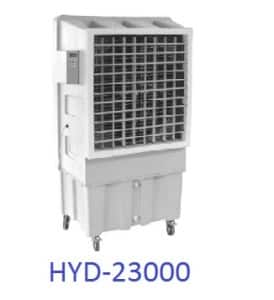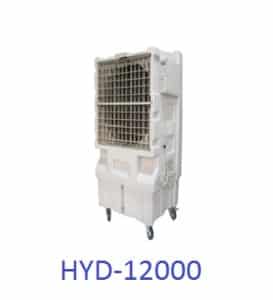Industrial Air Coolers are specialized heavy-duty cooling systems designed specifically for industrial applications throughout Dubai and the UAE. These powerful units provide effective cooling for data centers, factories, warehouses, and other industrial environments battling excessive heat. Due to their substantial size and capacity, these coolers are primarily intended for commercial and industrial settings rather than residential use. Industrial air coolers offer a more economical alternative to traditional cooling methods when implemented on a larger scale.
Evaporative air cooling represents the most cost-effective solution for cooling commercial or industrial applications. We also offer air cooler rental service within UAE for temporary cooling needs.
How Industrial Coolers Differ From Regular AC:
- Fresh Air Circulation: Produces fresh air rather than recirculating stale air
- Environmentally Friendly: No refrigerants means zero ozone layer depletion
- Energy Efficient: Relatively low power consumption, averaging only 1KW per unit
- Durable Construction: No rusting issues as all coolers feature plastic body components
Benefits of Modern Industrial Air Coolers:
- Improved Air Quality: Employees remain protected from air pollution
- Eco-Friendly Solution: Perfect for environmentally conscious projects
- Energy Conservation: Consumes minimal electrical energy
- Long-Term Reliability: Industrial air coolers offer exceptional durability
Industrial air coolers are engineered to deliver flawless performance in harsh workplace environments, making them ideal for offices, schools, malls, assembly halls, and similar spaces. These units are optimized to minimize resource consumption while maintaining appropriate temperatures throughout industrial environments.
Our Industrial Air Cooler Models
HYD-9000 Industrial Air Cooler
 | |
| Max airflow | 9000m3/h |
| Voltage | 120-127V/220-240V |
| Frequency | 50Hz/60Hz |
| Input power | 400w |
| Water consumption | 6-8L/H |
| Water tank capacity | 70L |
| Overall size | 860*530*1400mm |
| Weight | 38Kg |
| Noise | 65Db |
| Application area | 30-50 m2 |
HYD-12000 Industrial Cooler
HYD-18000 Portable Industrial Cooler
 | |
| Max airflow | 18000m3/h |
| Voltage | 220-240V |
| Frequency | 50Hz |
| Input power | 750w |
| Water consumption | 10-15L/H |
| Water tank capacity | 126L |
| Overall size | 1120*720*1500mm |
| Weight | 58Kg |
| Noise | 68Db |
HYD-23000 Industrial Portable Cooler
 | |
| Max airflow | 23000m3/h |
| Voltage | 220-240V |
| Frequency | 50Hz |
| Input power | 1.1Kw |
| Water consumption | 15-20L/H |
| Water tank capacity | 126L |
| Overall size | 1120*720*1750mm |
| Weight | 62Kg |
| Noise | 68Db |
How Evaporative Cooling Works
Industrial air coolers operate through the principle of water evaporation. Also known as swamp coolers, desert coolers, or wet air coolers, these systems provide a natural cooling mechanism that’s both effective and economical.
Maintaining a comfortable indoor atmosphere during hot summer months can be challenging and often expensive. Industrial evaporative coolers offer an eco-friendly, healthy, and cost-effective alternative to traditional air conditioning systems.
The cooling process mimics natural evaporation, similar to how water evaporating from oceans and rivers cools the surrounding air. When water evaporates, it requires heat to transform from liquid to vapor state. This heat is drawn from the surrounding air, resulting in a cooling effect. The same principle applies when a gentle breeze on a hot day cools us through evaporation of moisture from our skin.
The Evaporation Process
The cooling efficiency depends largely on ambient humidity levels. When air contains only 50% of its moisture capacity, there’s significant room for additional evaporation. In low-humidity environments, evaporative coolers achieve maximum efficiency as they can introduce substantial moisture into the air.
Unlike traditional air conditioners that rely on sealed environments, industrial evaporative coolers perform optimally with fresh air intake, such as through open windows or doors. This continuous air circulation ensures fresher indoor air quality compared to conventional AC systems.
For optimal performance, properly sizing your industrial air cooler to match your space requirements is essential. An undersized unit will operate inefficiently, consuming excess energy while struggling to maintain comfortable temperatures.
Most residential and industrial evaporative coolers utilize direct evaporation technology. A centrifugal fan powered by an electric motor draws air through water-saturated cooling pads, while a water pump continuously moistens these pads. These cooling units can be installed on roofs, external walls, or windows. As air passes through the damp pads, heat from the air evaporates water, and the resulting cooled, humidified air is then circulated throughout the building through appropriate ventilation.

